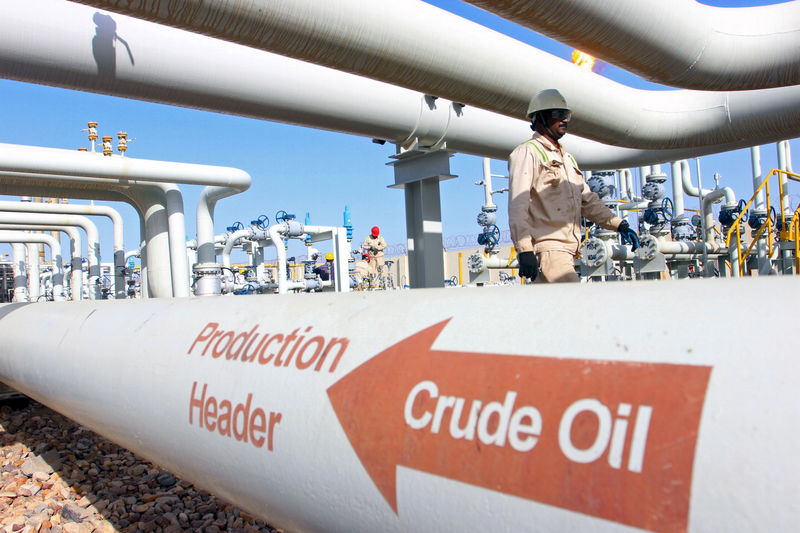* Oil highest in over 3 yrs on report Saudis want higher prices
* Resource stocks star as most Asian markets move ahead
* Risk of inflationary pulse a drag for fixed-income bonds
* Dollar mostly range bound, Aussie weathers weak jobs data
By Wayne Cole
SYDNEY, April 19 (Reuters) - Resource stocks were on a roll in Asia on Thursday as oil prices hit heights not seen since late 2014 and ignited a rally across commodities, though the potential boost to inflation globally also put some pressure on fixed-income assets.
Brent crude futures LCOc1 climbed another 37 cents to stand at $73.85 a barrel, adding to a 2.7 percent jump overnight. U.S. crude CLc1 gained 26 cents to $68.73.
The surge came on a Reuters report that OPEC's new price hawk Saudi Arabia would be happy for crude to rise to $80 or even $100, a sign Riyadh will seek no changes to a supply-cutting deal even though the agreement's original target is within sight. Saudis and their colleagues in OPEC need higher oil for their fiscal positions and the Kingdom is on a bold – and costly – reform program," said Greg McKenna, chief market strategist at CFD and FX provider AxiTrader.
"So, they might continue to squeeze the lemon while they have the chance and the hand."
The leap in oil combined with fears that sanctions on Russia could hit supplies of other commodities to light a fire under the entire sector. Aluminium prices reached their highest since 2011, alumina touched an all-time peak and nickel jumped the most in 6-1/2 years. MET/L
Such increases, if sustained, could fuel inflationary pressures and investors hedged by selling sovereign bonds.
Yields on U.S. two-year Treasuries US2YT=RR stood at levels last visited in 2008 at 2.43 percent.
EXTRA ENERGY
Resource stocks were the big winners, driving Chinese blue chips .CSI300 up 1.1 percent. MSCI's broadest index of Asia-Pacific shares outside Japan .MIAPJ0000PUS added 0.9 percent, with energy up over 2.6 percent.
Japan's Nikkei .N225 faded late in the day to end up 0.15 percent, but basic materials and utilities both climbed more than 2 percent.
The bullish sentiment in markets comes amid wider optimism about economic growth. The global economy is expected to expand this year at its fastest pace since 2010, the latest Reuters polls of over 500 economists worldwide suggest, but trade protectionism could quickly slow it down. ECILT/WRAP
Investors were also relieved that no new U.S. demands on trade came out of a summit between Japanese Prime Minister Shinzo Abe and U.S. President Donald Trump. futures for the S&P 500 ESc1 rose 0.1 percent, as did futures for the FTSE FFIc1 .
Wall Street had also seen hefty gains in the energy and industrial indexes, though that was offset by softness in sectors such as consumer staples and financials. .N
IBM 's IBM (NYSE:IBM).N 7.5 percent drop was the biggest drag on the S&P after the technology company's quarterly profit margins missed Wall Street targets. Dow .DJI ended down 0.16 percent, while the S&P 500 .SPX gained 0.08 percent and the Nasdaq .IXIC 0.19 percent.
In currency markets, the U.S. dollar remained range bound with its index a fraction firmer at 89.669 .DXY . It gained a touch on the yen to 107.46 yen JPY= , but stayed short of recent peaks at 107.78.
The euro hovered at $1.2374 EUR= , within striking distance of the week's top of $1.2413.
The strength in commodity prices helped the Australian dollar AUD=D4 easily weather unexpectedly soft jobs data, with employment rising by a meagre 4,900 in March. AUD/ out from New Zealand also showed annual inflation there had slowed to just 1.1 percent in the first quarter, underlining expectations that interest rates would remain at record lows for many more months to come. MSCI and Nikkei chart
http://reut.rs/2sSBRiD
^^^^^^^^^^^^^^^^^^^^^^^^^^^^^^^^^^^^^^^^^^^^^^^^^^^^^^^^^^^> (Editing by Sam Holmes & Shri Navaratnam)
